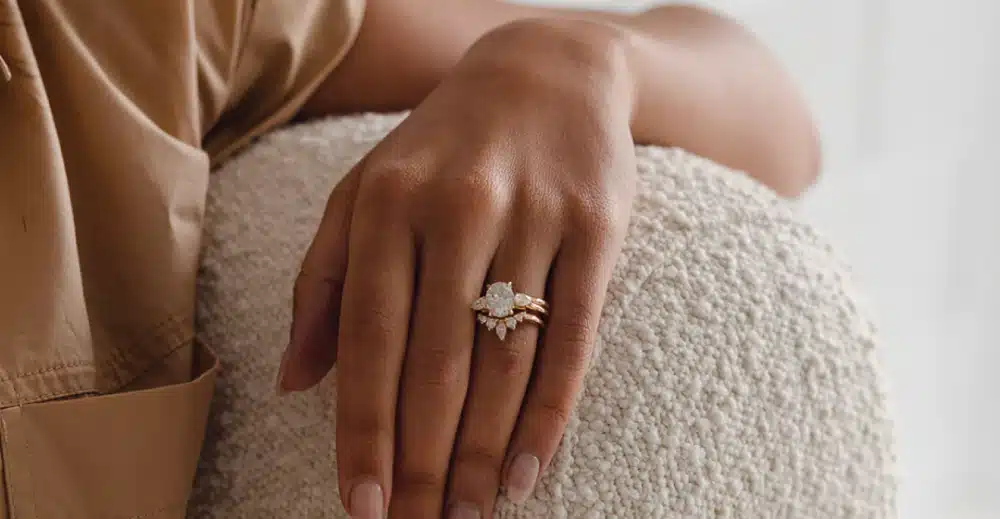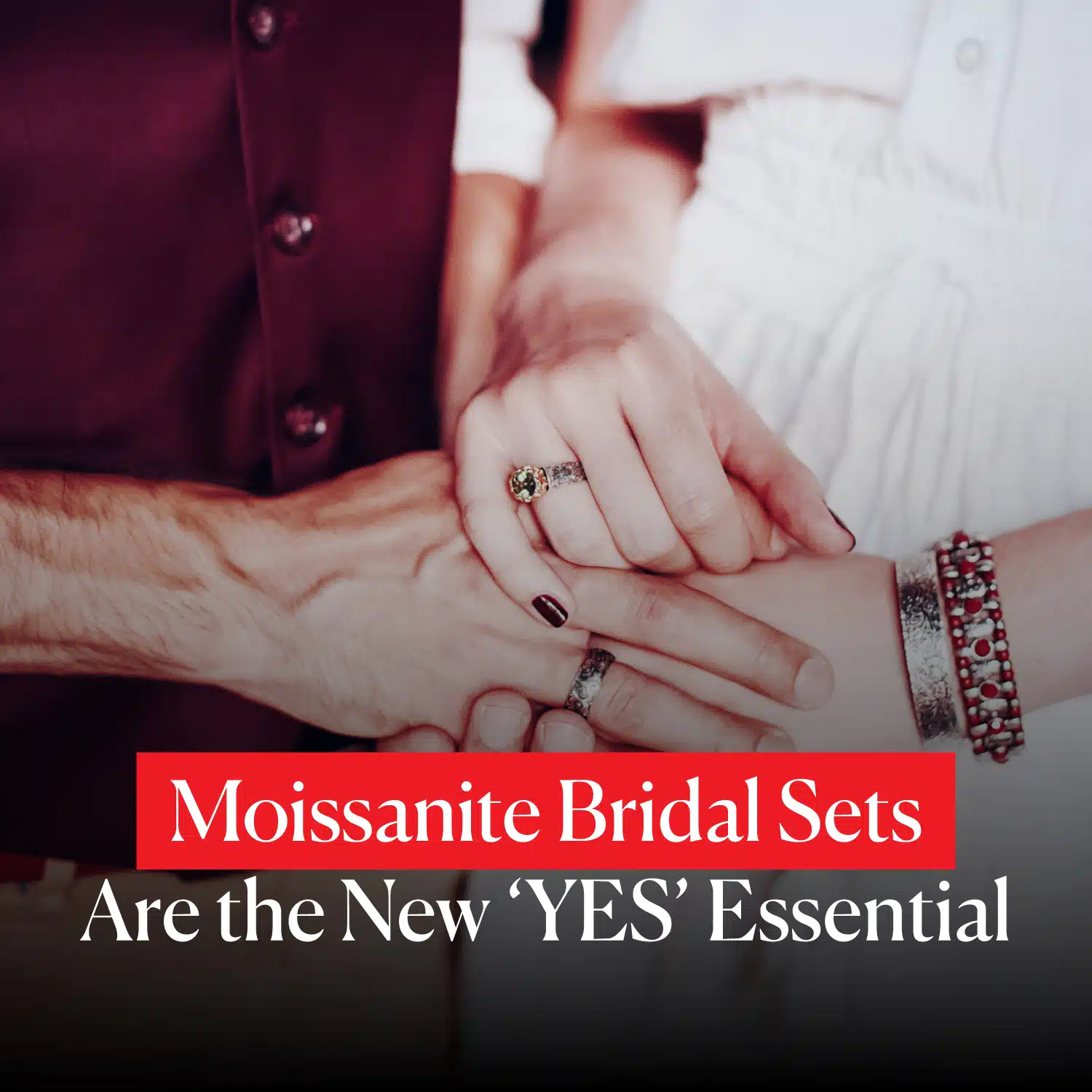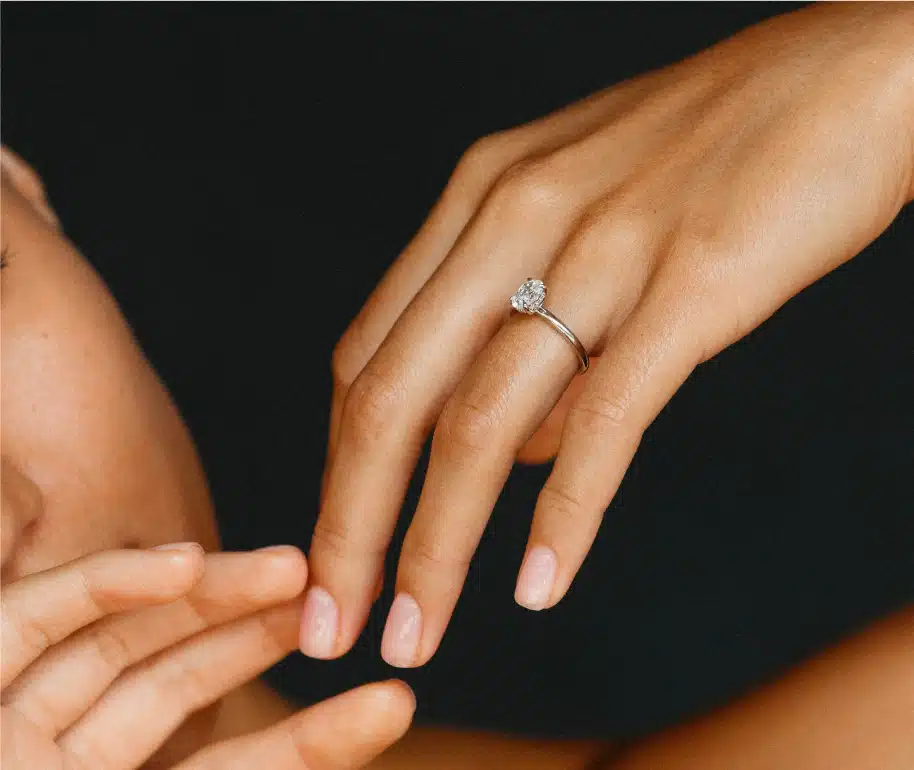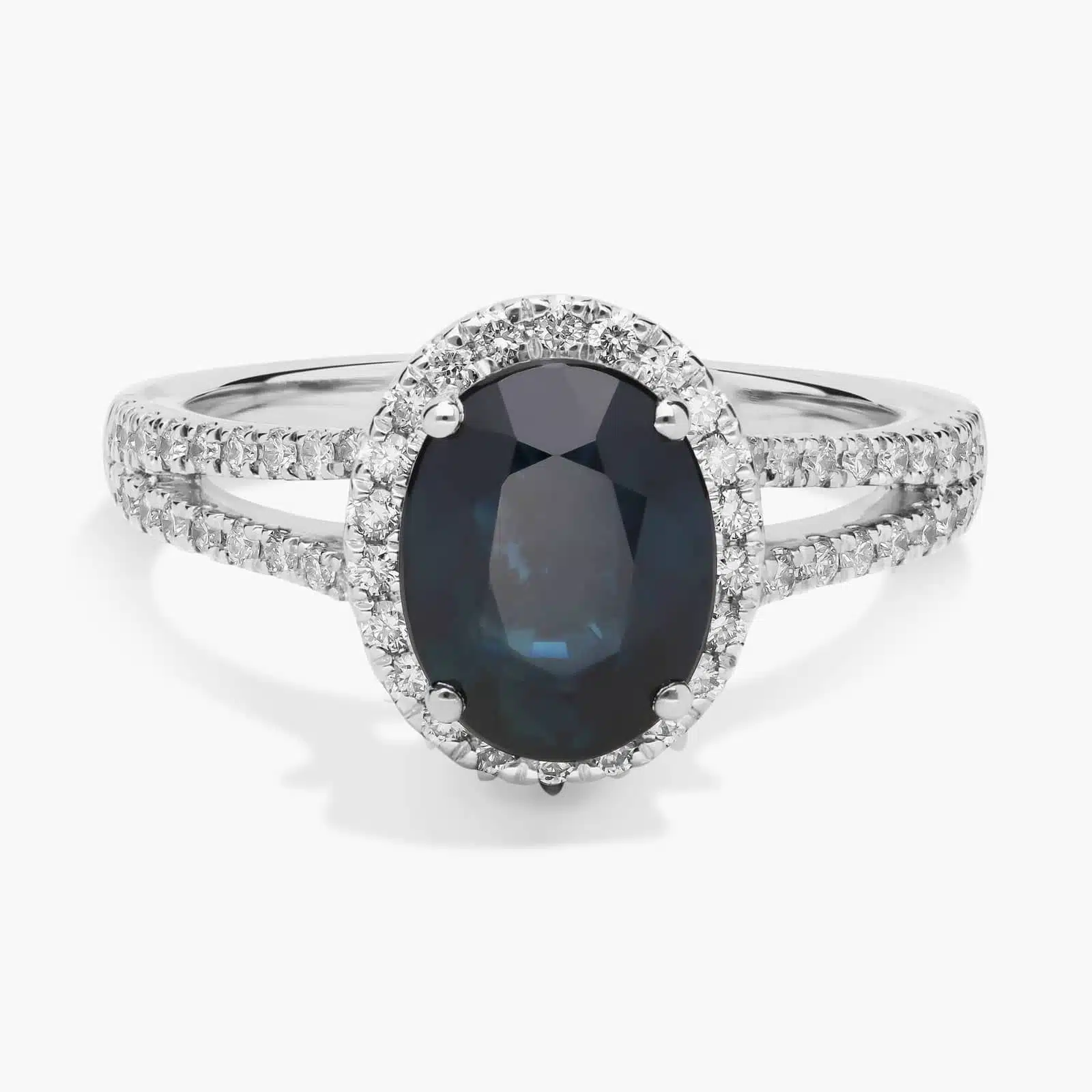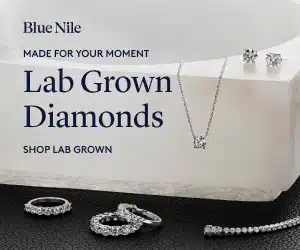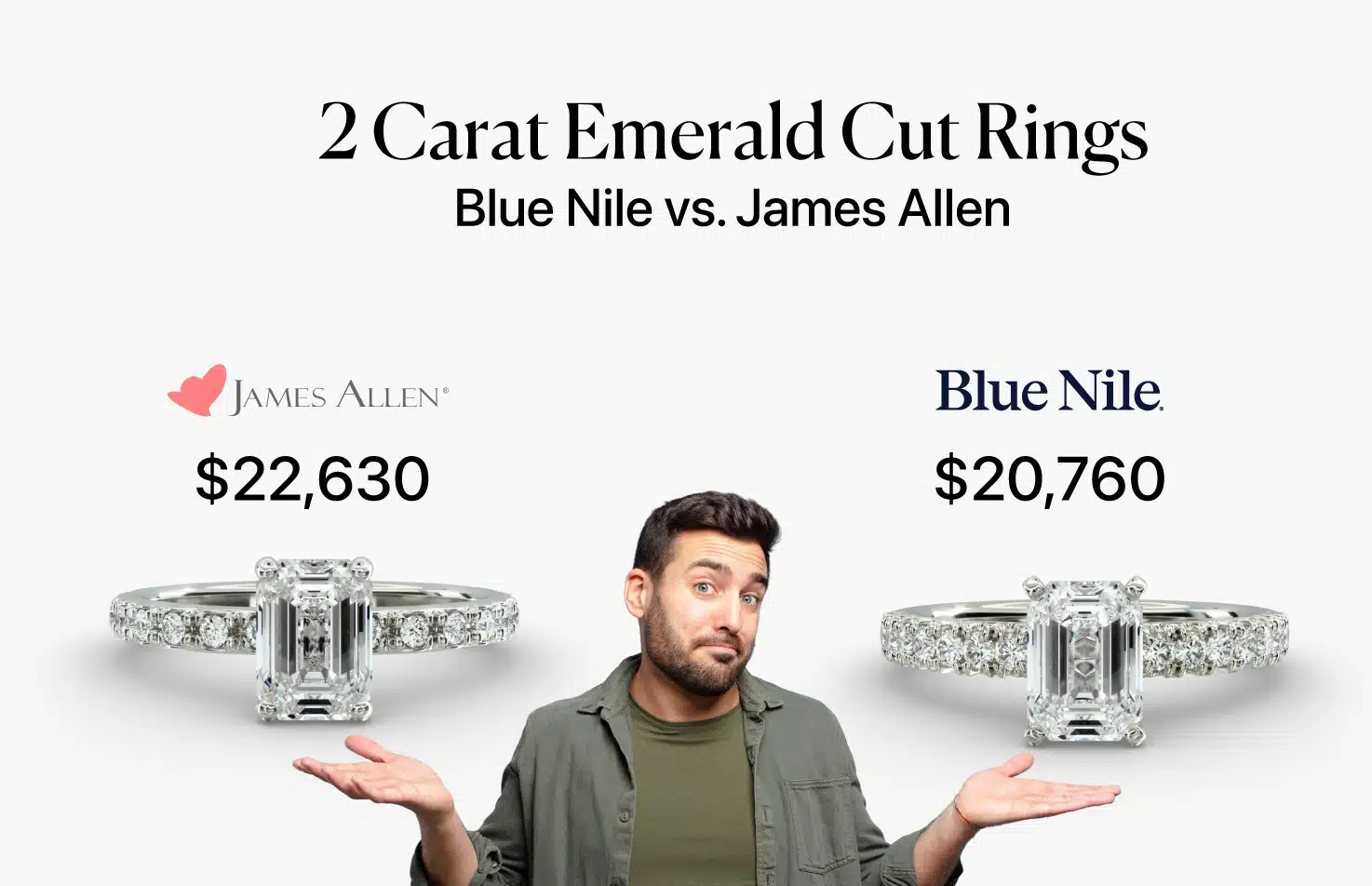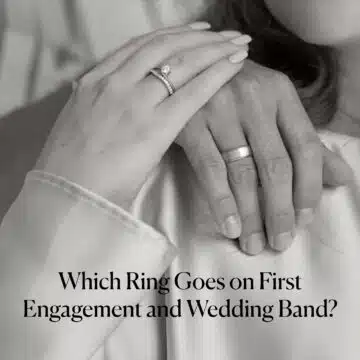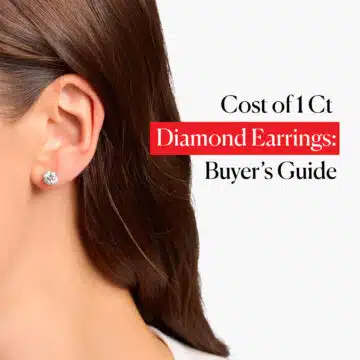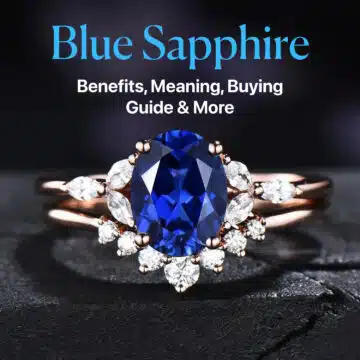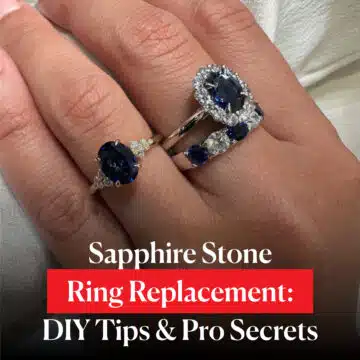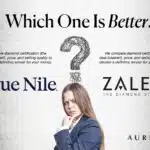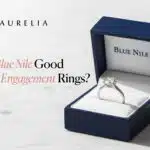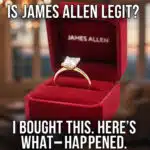When choosing between Blue Nile and James Allen for a 2 carat emerald cut ring, the smartest choice depends entirely on whether you’re buying a natural or lab-grown diamond.
For natural diamonds, the prices are nearly identical, making James Allen’s superior viewing technology the deciding factor. But for lab-grown diamonds, Blue Nile can offer a shocking price advantage, as you’ll see in our real-time comparison.
I’m going to walk you through a live build of four rings using these exact screenshots, so you can see for yourself where the real value lies in the debate of the best places to buy engagement rings online.
Diamond IQ Test: Natural or Lab-Grown?
Two identical diamonds: GIA Certified, 1.51ct, D Color, VVS1, Ideal Cut. One is natural ($16,530), the other is lab-grown ($2,390). Choose the diamond you like better and see if you can match it to its origin.
The Core Problem: Why This Choice is Crucial for an Emerald Cut
You’ve chosen an emerald cut, and frankly, I applaud your taste. You’ve opted for elegance, for a classic Art Deco beauty that stands apart from the crowd with Celebrities like Beyoncé, Jennifer Lawrence, Amal Clooney, Grace Kelly, and Paris Hilton.
But here’s the inside-the-business truth you have to understand: an emerald cut plays by a completely different set of rules than almost any other diamond shape.
Most diamonds people buy—like round brilliants, cushions, or radiants—are brilliant-cut. Think of them like a disco ball with dozens of tiny, angled facets designed for one primary mission: to create sparkle. That fiery, crushed-ice effect is brilliant at breaking up light and, just as importantly, it’s brilliant at hiding small flaws or inclusions within the stone.
An emerald cut does the exact opposite.
It is a step cut, which means it has long, straight, architectural facets that run parallel to the edge. This creates a mesmerizing effect known as a “hall of mirrors.” It doesn’t create fiery sparkle; it produces dramatic, elegant flashes of light. Think of it less like a disco ball and more like a perfectly clear, deep pool of water.
So what does this mean for you? It means an emerald cut is an open window into the very heart of the diamond. There is nowhere for flaws to hide. A tiny carbon spot that would be utterly invisible in a round brilliant can look like a speck of pepper on a white dinner plate in the middle of an emerald cut.
This is why a GIA certified report, while essential, is not enough to protect you. The report tells you a diamond’s clarity characteristics on paper, but it cannot tell you if an inclusion’s location will make it glaringly obvious to the naked eye.
Your entire goal is to find a diamond that is eye-clean—a stone where no inclusions are visible without magnification. For an emerald cut, this is not something you can determine from a grading report alone. You absolutely must see the stone’s true light performance and inspect it from every angle yourself.
And that is the entire battleground for this comparison. This is where the choice between the two biggest names in the business, which I break down in my full James Allen Review and Blue Nile Review, becomes the most important decision you’ll make. It’s not just about who has a better website; it’s about who gives you a better view through that window.
Real-Time Showdown: I’m Building 4 Rings Based on Today’s Prices
Talk is cheap. Anyone can give you generic advice, but in a purchase this important, a decision that will cost tens of thousands of dollars, what you need is hard evidence.
You need to see the numbers, the diamonds, the official certificates, and the final rings for yourself.
So that’s exactly what we’re going to do.
I’ve gone on both James Allen and Blue Nile and have taken screenshots from a live, real-time comparison. This isn’t a theoretical exercise based on old data; this is the reality of the market right now.
Best Deal Of The Year – Final Days
Blue Nile’s “Clear The Vault” is ON.
Shop Fine Jewelry Upto 70% OFF.
*Exclusions may apply. See Blue Nile for complete details.
Our mission was to build the absolute best ring targeting the top tier of quality: a flawless 2 Carat, D-Color, VS2-Clarity Emerald Cut Diamond set in a timeless and elegant pavé platinum band.
We will meticulously build two rings with natural, earth-mined diamonds—the classic choice. Then, we will do the exact same thing with two stunning, physically identical lab-grown diamonds to see how the value proposition completely transforms.
I’m going to walk you through every single detail, from analyzing the GIA certificates like a gemologist to comparing the final price tags like an accountant. This is the ultimate head-to-head showdown. Let the results speak for themselves.
DIAMOND ON SALE!!
⏰ Tick-Tock! The Best Diamond Deals at James Allen Are Disappearing Fast!
Case Study #1: A Natural 2 Carat Emerald Diamond at Blue Nile
Our first stop is Blue Nile, one of the most established and trusted names in the online diamond world. Our goal is to find the best possible 2-carat, D-Color, VS2-Clarity natural diamond and pair it with a classic setting to establish our benchmark for quality and price.
Step 1: The Diamond Search & Selection
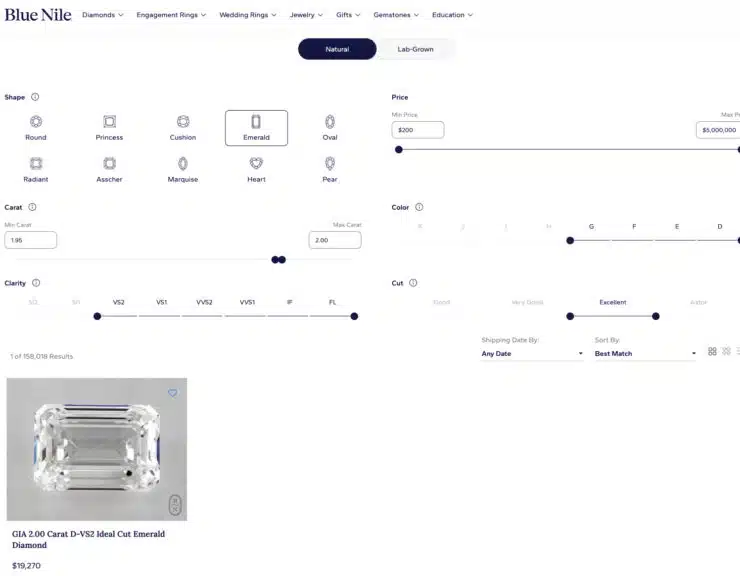
As the first screenshot shows, we started with Blue Nile’s powerful search filter. We narrowed the hunt to the very best:
- Shape: Emerald
- Carat: 1.95 – 2.00
- Color: D (the highest grade)
- Clarity: VS2 (our target for an eye-clean stone)
- Cut: Excellent/Ideal (Blue Nile’s top tier)
The search yielded an immediate, high-potential candidate: a GIA 2.00 Carat D-VS2 Ideal Cut Emerald Diamond. The price listed for this loose stone is $19,270. This is our foundational number.
Step 2: Decoding the GIA Certificate – The Diamond’s DNA
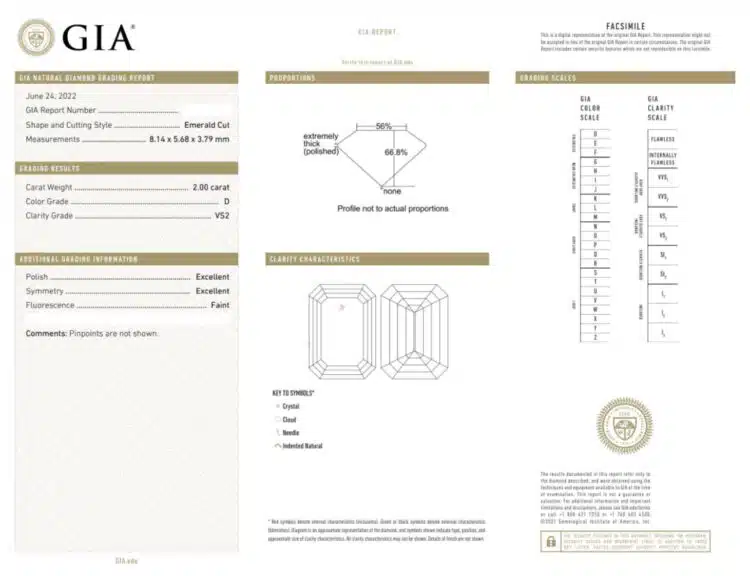
Before going any further, we must act as gemologists and dive deep into the GIA report, which is fully visible in your screenshots. This is where we verify that the diamond isn’t just great on paper, but has the characteristics we need.
- The Plotting Diagram: This is our treasure map. The GIA has identified several minor inclusions: “Crystal,” “Cloud,” and “Needle.” Crucially, look where they are located on the diagram—they are all clustered together off to one side of the stone.
This is the absolute best-case scenario for a VS2 emerald cut. An inclusion in the dead center can be a deal-breaker, but when they are grouped to the side like this, they are easily hidden by a facet’s edge and will be completely invisible to the naked eye. - Polish and Symmetry: The certificate confirms “Excellent” grades for both. For a step-cut like an emerald, this is paramount.
Excellent symmetry guarantees that the long, clean lines of the “hall of mirrors” are perfectly aligned for those dramatic flashes of light. Excellent polish means the surfaces are flawlessly smooth, like a perfect pane of glass.
- Fluorescence: The report notes “Faint.” Let me be clear as your friend in the business: this is a non-issue. In a D-color diamond, faint fluorescence is invisible and has zero impact on its beauty or value. Do not let it deter you.
- Measurements & Ratio: The certificate shows the dimensions are 8.14 x 5.68mm. This gives it a length-to-width ratio of 1.43, a fantastic, classic rectangular shape for an emerald cut that will look elegant and provide great finger coverage.
Step 3: A Crucial Observation – Verifying with 360° Video
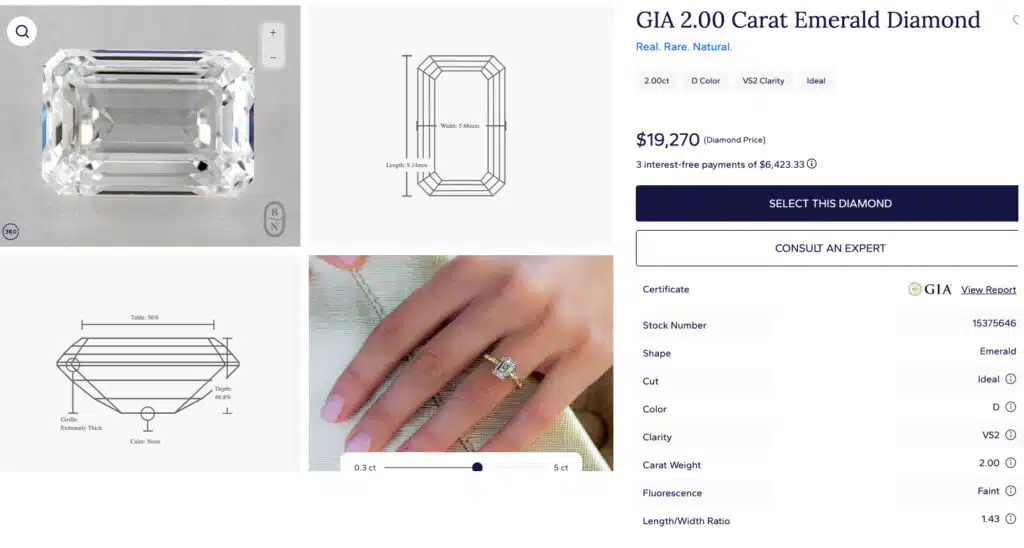
Look closely at the diamond detail page—Blue Nile provides a 360° viewing video for this stone! While James Allen is more famous for this technology, Blue Nile is clearly catching up and offers this essential tool on many of their diamonds.
This allows us to take the information from the GIA report and confirm it with our own eyes. By rotating the diamond in the video, we can personally verify that the cluster of VS2 inclusions on the side is completely non-visible.
We can see the excellent light performance promised by the symmetry grade. This is how a smart buyer eliminates risk. We aren’t just trusting the report; we are confirming its findings visually.
Step 4: Choosing the Setting – A Smart & Beautiful Choice
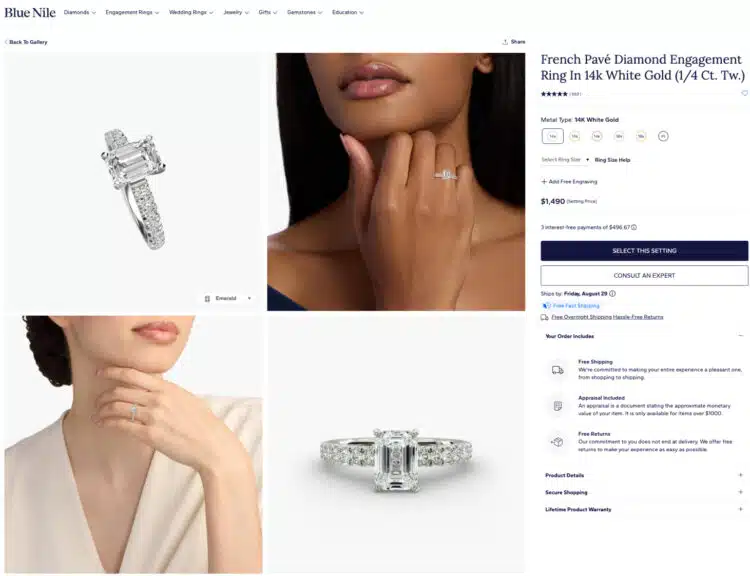
Now that we have a confirmed, top-tier diamond, we pair it with a setting. The screenshot shows we have selected the “French Pavé Diamond Engagement Ring in 14k White Gold.” This is an important distinction from our previous draft.
- Metal Choice: 14k White Gold. This is a savvy decision. It provides the same cool, silvery-white look as platinum, ensuring the D-color diamond remains bright white. However, 14k white gold is less dense than platinum, making it a more accessible price point without sacrificing the classic aesthetic.
- Setting Style: The “French Pavé” style, as we discussed, is designed for maximum sparkle from the accent diamonds on the band, providing a beautiful complement to the emerald’s flashes of light. This specific setting has a total of 1/4 carats of smaller diamonds.
- Setting Price: The cost for this beautiful setting is $1,490.
Step 5: The Final Verdict & True Price
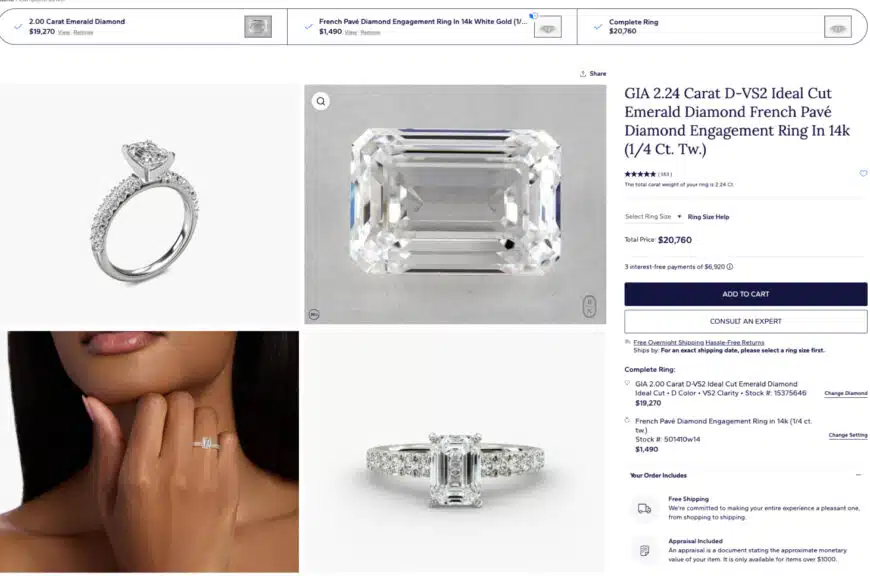
With our visually-verified diamond locked in and our elegant setting chosen, we arrive at the final, accurate price. The screenshot of the completed ring shows the diamond price $19,20 and the setting price $1490 combining for a total, all-inclusive cost of $20,760.
This is our definitive benchmark. We have a top-of-the-line, 2.00 carat, D-color, VS2-clarity natural diamond in a stunning 14k white gold setting, all for a verified price of $20,760 from Blue Nile. Now, we will see how James Allen compares to this number.
Case Study #2: A Natural 2 Carat Emerald Diamond at James Allen
Now we take our exact same high standards to James Allen, the retailer renowned for its industry-leading technology. The mission is to find a diamond that matches the Blue Nile stone on paper and see how the real-world cost and experience compare.
Step 1: The Diamond Search & Selection
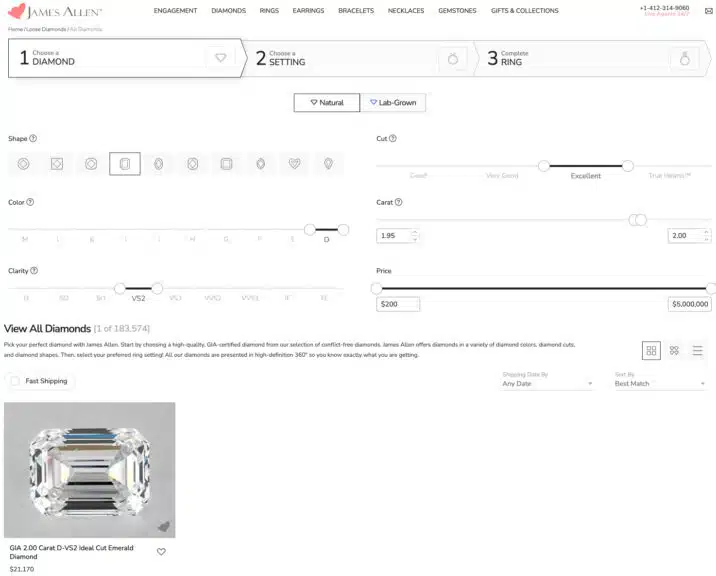
The first screenshot shows us navigating the James Allen interface, which is clean and intuitive. We’ve applied the identical top-tier filters to ensure a fair fight:
- Shape: Emerald
- Carat: 1.95 – 2.00
- Color: D (the best possible)
- Clarity: VS2 (our “sweet spot” target)
- Cut: Excellent
The search engine quickly presents us with a prime candidate: a GIA 2.00 Carat D-VS2 Ideal Cut Emerald Diamond. However, the very first thing we must notice is the price. The price for this loose diamond is listed at $21,170.
Immediately, this is a major data point. Compared to the verified $19,270 diamond from Blue Nile, this comparable stone from James Allen is $1,900 more expensive right from the start.
Step 2: Decoding the GIA Certificate
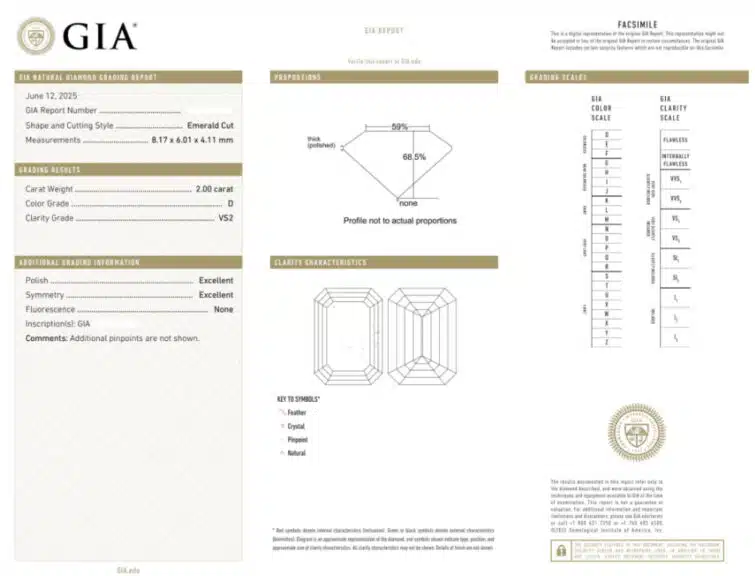
Before making any judgments, we must analyze this diamond’s “birth certificate.” Your screenshot provides the full GIA report, which gives us a complete and unbiased breakdown of its quality.
- The Plotting Diagram: The GIA has identified this stone’s clarity characteristics as “Feather,” “Crystal,” and “Pinpoint.” Looking at the map, we can see these inclusions are more scattered than the Blue Nile stone, with a couple located more centrally under the table facet.
This makes a VS2 grade slightly more complex; it doesn’t mean it isn’t eye-clean, but it absolutely means the next step—visual verification—is non-negotiable. - Polish and Symmetry: As expected for a premium diamond, both are graded “Excellent.” This ensures the diamond will have sharp, clean lines and beautiful light return.
- Fluorescence: The certificate confirms “None.” On a technical level, this is superior to “Faint,” but in reality, for a D-color diamond, the visual difference between “None” and “Faint” is zero. It’s a small victory on paper but not one that translates to visible beauty.
- Measurements & Ratio: The certificate lists the measurements at 8.17 x 6.01mm. This gives it a length-to-width ratio of approximately 1.36.
This is a matter of personal taste—it’s a slightly less elongated, “stronger” rectangular shape compared to the 1.43 ratio of the Blue Nile diamond.
Step 3: Verifying with the 360° HD Video – The James Allen Advantage
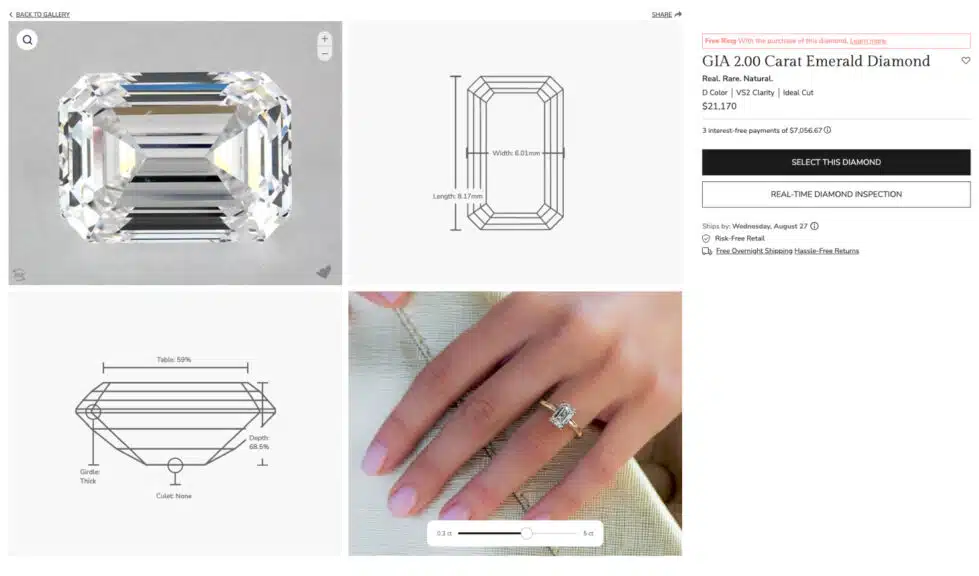
Given that the inclusions on this diamond’s plot were more scattered, this next step is the most critical part of the entire James Allen process. The screenshot shows the diamond in the renowned 360° high-definition viewer.
This tool is why James Allen has built such a loyal following. It allows us to become our own gemologist. I can zoom in to 40x magnification and slowly rotate the stone to hunt for those inclusions listed on the GIA report.
I can personally confirm whether that central “Pinpoint” or “Crystal” is visible to the naked eye. In this case, the video would likely prove the diamond is indeed eye-clean, but the ability to prove it to yourself removes an enormous amount of stress and uncertainty from the process.
You are not just trusting my advice or a GIA report; you are verifying the quality with your own eyes. This is the definition of a confident purchase.
Step 4: Choosing the Setting – A Perfect Match
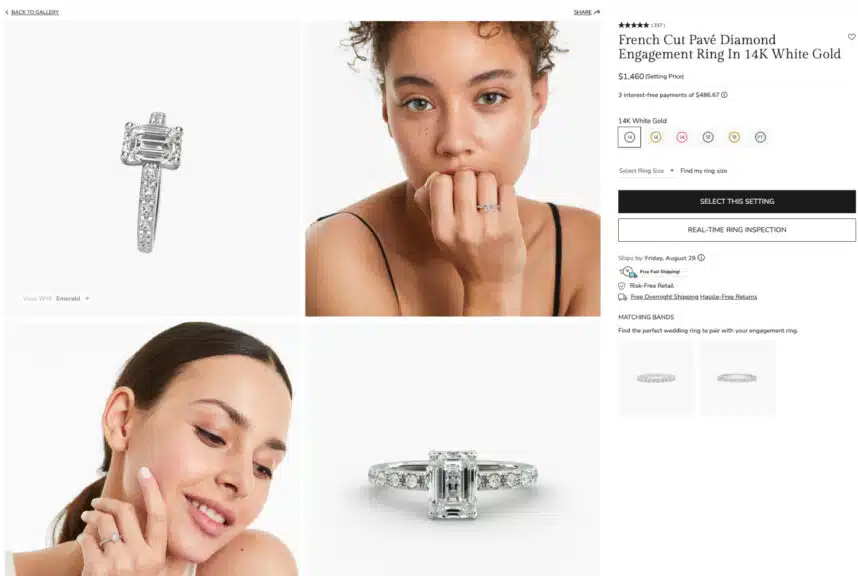
To ensure our comparison remains perfectly fair, we have selected the “French Cut Pavé Diamond Engagement Ring in 14k White Gold” from the screenshots. This is the direct stylistic equivalent to the setting we chose from Blue Nile, featuring the same pavé style on the band and the same metal.
The price for this high-quality setting at James Allen is $1,460. This is a minor win for James Allen, coming in at $30 cheaper than Blue Nile’s setting.
Step 5: The Final Verdict & True Price
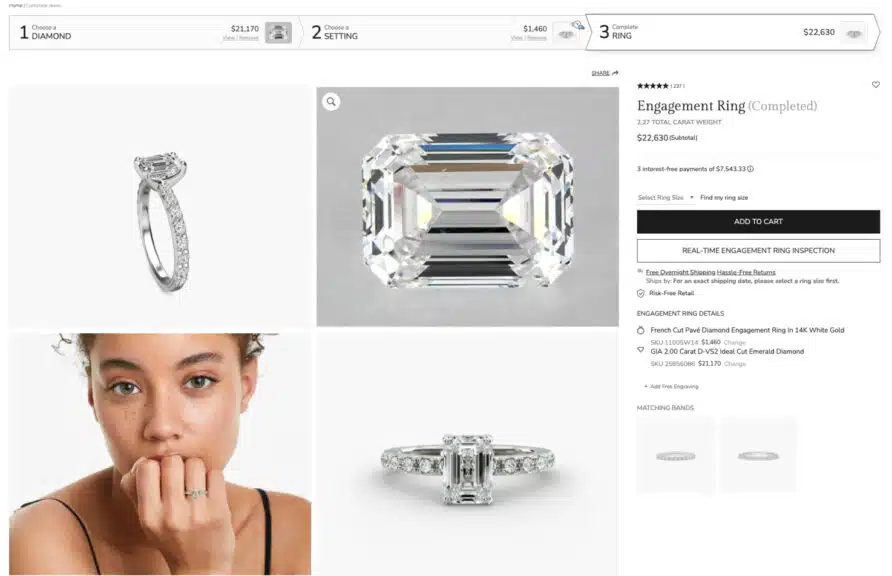
Now we assemble the components to get our final, all-inclusive price. The screenshot of the completed ring shows the diamond price ($21,170) and the setting price ($1,460). The final, total price for the James Allen ring comes to $22,630.
When we compare this to our definitive Blue Nile benchmark of $20,760, the difference is stark. The James Allen ring is $1,870 more expensive.
While its viewing technology is undeniably superior and provides incredible peace of mind, the evidence from this specific, real-time comparison shows that this confidence comes at a significant financial premium for this particular natural diamond.
Case Study #3 & #4: The Lab-Grown Revolution at Blue Nile & James Allen
Now, we enter the most dynamic and value-driven part of the market: lab-grown diamonds. These are real diamonds, identical in every way to their natural counterparts, except for their origin and their price.
We are targeting the exact same specs: D-Color and VS2-Clarity in a French pavé 14k white gold setting.
However, the market for lab-grown stones means we won’t find an exact 2.00-carat match for both. What we found instead is even more interesting: a 2.01-carat stone from Blue Nile versus a 1.99-carat stone from James Allen. This tiny difference on paper leads to a shocking difference in price, and it’s a masterclass in how to be a smart shopper.
The Blue Nile Lab-Grown Ring

First, let’s analyze the Blue Nile offering. The screenshot shows a completed ring built with a beautiful IGI-certified 2.01 carat, D-color, VS2-clarity lab-grown emerald cut.
- The Diamond: At 2.01 carats, this diamond just crosses over that “magic” 2.00-carat threshold. It is, by definition, a two-carat diamond, which holds significant psychological appeal. It’s paired with the same “French Pavé Diamond Engagement Ring” in 14k white gold, costing $1,490.
- The Price: The loose 2.01 ct diamond is listed at $2,930.
- The Verdict & Final Cost: When combined, the final, all-inclusive price for the Blue Nile lab-grown ring is $4,420. This is an incredible value compared to the $20k+ natural ring, establishing a strong starting point for our lab-grown comparison.
The James Allen Lab-Grown Ring
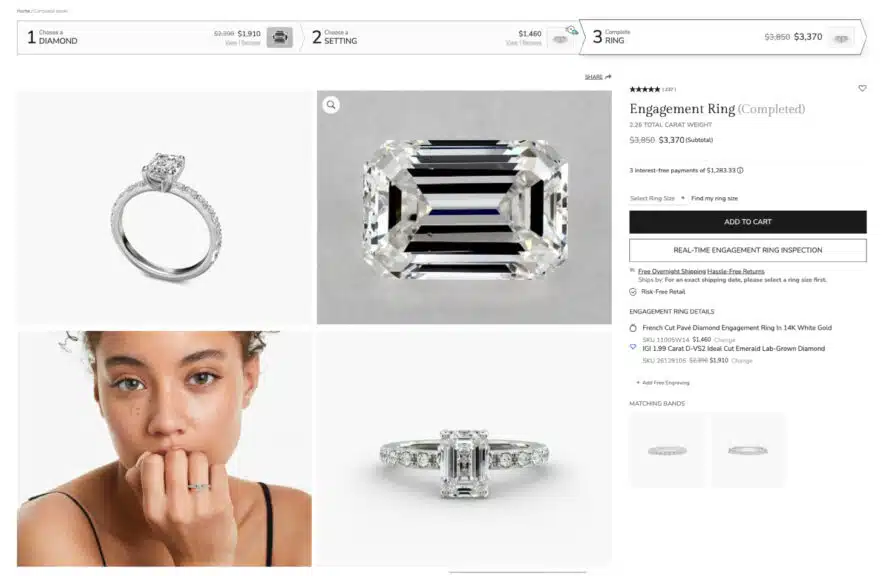
Now, let’s turn to the James Allen build. This is where, as your friend in the business, I want you to pay extremely close attention. This is a perfect example of an “insider’s move” that can save you a huge amount of money.
The screenshot shows a completed ring with an IGI-certified 1.99 carat, D-color, VS2-clarity lab-grown emerald cut.
- The Diamond: A Savvy Choice. The carat weight here is 1.99. To the naked eye, the difference between a 1.99-carat diamond and a 2.01-carat diamond is physically impossible to see. They are, for all visual purposes, the exact same size.
However, because it falls just under that magic 2.00-carat mark, it doesn’t carry the same price premium. This is a strategy called “buying shy,” and it is the single smartest way to maximize your budget. - The Price: The loose 1.99 ct diamond is listed at a stunningly low $1,910. The setting is the comparable “French Cut Pavé” in 14k white gold for $1,460.
- The Verdict & Final Cost: The total, all-inclusive price for the James Allen lab-grown ring is just $3,370.
Let’s put this in perspective. The James Allen diamond is visually identical in size to the Blue Nile one. The quality is the same. The setting is the same. Yet, the final ring from James Allen is $1,050 cheaper.
That is not a small difference; it is a massive 23.7% savings for making one tiny, smart decision on carat weight. In this direct, evidence-based showdown, James Allen delivers a landslide victory on value for lab-grown diamonds.
The Final Scorecard: What This Data Actually Means For You
We’ve just gone through an intense, evidence-based showdown. We’ve analyzed GIA certificates, compared proprietary technology, and—most importantly—we have the final, verified price tags for four distinct, high-quality rings. It’s a lot of information, and it can feel overwhelming.
So let’s cut through the noise. This is the moment where I, as your friend in the business, distill everything down into a simple, powerful conclusion. The numbers don’t lie, and they tell two very different stories depending on what kind of diamond you are buying.
Forget what you thought you knew about these retailers. Here is the hard evidence from our real-time comparison.
First, the simple, scannable truth:
| Ring Type | James Allen Final Price | Blue Nile Final Price | The Winner |
| NATURAL DIAMOND | $22,630 | $20,760 | Blue Nile (on Price) |
| LAB-GROWN DIAMOND | $3,370 | $4,420 | James Allen (on Value) |
Now, looking at that table, you might think the decision is easy. Just pick the cheapest one, right? Not so fast. The raw numbers only tell half the story. The real value—the confidence you feel, the quality you’re assured of, and the long-term happiness with your purchase—lies in the details behind those numbers.
Let me break down my professional verdict for you, piece by piece.
My Verdict for the NATURAL Diamond Buyer
On paper, Blue Nile won this round on price, and a nearly $2,000 savings is significant and cannot be ignored. But this is a perfect example of a decision that goes beyond the spreadsheet.
While your wallet might initially point to Blue Nile, my expertise and experience compel me to give you different advice.
- The Blue Nile Advantage:
- A Clear Price Win: In our specific test, the loose 2.00-carat, D-VS2 diamond at Blue Nile was $1,900 cheaper than the comparable stone at James Allen. This was the single biggest factor in the final price difference.
- Proven Quality: The GIA certificate was excellent, and the availability of a 360° video on their site allowed us to confirm it was a top-tier diamond.
- The Bottom Line: You could buy the Blue Nile ring for $20,760 and get a beautiful, high-quality piece of jewelry.
- A Clear Price Win: In our specific test, the loose 2.00-carat, D-VS2 diamond at Blue Nile was $1,900 cheaper than the comparable stone at James Allen. This was the single biggest factor in the final price difference.
- Why I Still Recommend James Allen (and Why It’s Worth It):
- Technology is a Tool of Confidence: James Allen’s 360° HD video isn’t just a feature; it is the single most powerful tool for consumer confidence in the online diamond industry. It is consistently higher quality, easier to use, and more detailed than competitors.
- The Importance of “Knowing”: The James Allen GIA report showed a more scattered inclusion plot. For many buyers, that would be a source of anxiety. But their technology removes that anxiety completely.
You don’t have to trust that the diamond is eye-clean; you can prove it to yourself by examining it from every angle under 40x magnification. - Value Isn’t Just Price: In a $20,000+ purchase, is it worth paying a premium to have 100% certainty and zero doubt? For most people, the answer is a resounding yes.
You are not just buying a diamond; you are buying the peace of mind that comes with making the absolute best possible choice. The James Allen experience is engineered to provide that peace of mind.
- Technology is a Tool of Confidence: James Allen’s 360° HD video isn’t just a feature; it is the single most powerful tool for consumer confidence in the online diamond industry. It is consistently higher quality, easier to use, and more detailed than competitors.
- Final Recommendation for Natural Buyers:
- If your decision is driven by the absolute lowest price on a top-spec diamond, and you find a stone on Blue Nile with a great certificate and a video to verify it, you can get a great deal.
- However, my professional recommendation is to give your business to James Allen. The confidence and certainty their superior technology provides during the selection process are worth the premium in a purchase this significant. It is the smartest way to guarantee you will be happy with your choice.
- If your decision is driven by the absolute lowest price on a top-spec diamond, and you find a stone on Blue Nile with a great certificate and a video to verify it, you can get a great deal.
Blue Nile is one of the biggest and most recognized online jewelry retailers, offering an extensive and exclusive inventory. Their high-resolution images are improving and getting closer to the quality offered by James Allen, while their prices remain highly competitive. Right now, Blue Nile offers up to 30% savings on jewelry during a limited-time sale.
WHAT WE LOVE ABOUT THEM:
- 30-day no-questions-asked return policy, with a prepaid shipping label provided by Blue Nile.
- Lifetime warranty on all purchases.
- Free shipping on every order.
- Complimentary services every six months, including prong tightening, repolishing, rhodium plating, and cleaning.
- Insurance appraisal included with your purchase.
- One free resizing within the first year.
- High-quality images available for roughly half of their diamond selection.
- 24/7 customer service support.
- Full credit toward future upgrades, as long as the new item is at least double the value.
- Best-in-class order fulfillment process.
My Verdict for the LAB-GROWN Diamond Buyer
This is where the entire narrative flips. The lab-grown market is younger, more dynamic, and this comparison revealed a stunning, undeniable winner that should make every smart shopper pay very close attention.
- The James Allen Knockout Victory:
- A Massive Price Advantage: Let’s be crystal clear. The James Allen ring was $1,050 cheaper than the Blue Nile ring. This is a staggering 23.7% savings. It is a complete and total victory on the most important factor for many buyers: the final cost.
- The “Buying Shy” Strategy in Action: This win was engineered by a brilliant purchasing strategy. We chose a 1.99-carat diamond. To your eyes, your partner’s eyes, and everyone else’s eyes, it is a 2-carat diamond.
But on the price tag, falling just below that magic 2.00-carat number created an enormous discount. This is the single smartest “insider move” you can make. - The Best of Both Worlds: This is the most amazing part. Not only did James Allen win on price, but you still get the benefit of their superior 360° technology. You are paying significantly less money and getting more confidence in your purchase. It’s an unbeatable combination.
- A Massive Price Advantage: Let’s be crystal clear. The James Allen ring was $1,050 cheaper than the Blue Nile ring. This is a staggering 23.7% savings. It is a complete and total victory on the most important factor for many buyers: the final cost.
- The Blue Nile Situation:
- The Cost of a Number: The 2.01-carat Blue Nile diamond carried a significant price premium simply for crossing that 2.00-carat mark. You were paying an extra $1,050 for a single hundredth of a carat that has no visual impact.
- Still a Great Value: It is important to state that at $4,420, the Blue Nile ring is still an incredible value compared to a natural diamond. It is not a bad choice by any means; it was simply beaten on strategy and price in this specific comparison.
- The Cost of a Number: The 2.01-carat Blue Nile diamond carried a significant price premium simply for crossing that 2.00-carat mark. You were paying an extra $1,050 for a single hundredth of a carat that has no visual impact.
- Final Recommendation for Lab-Grown Buyers:
- This isn’t a nuanced decision. The evidence is overwhelming. You should buy your lab-grown engagement ring from James Allen.
- Use the “buying shy” strategy. Set your carat weight filter to end at 1.99 (or 1.49, 2.49, etc.) to unlock the best possible value. You will get a visually identical ring and save thousands of dollars. The data from our own test proves it beyond a shadow of a doubt.
- This isn’t a nuanced decision. The evidence is overwhelming. You should buy your lab-grown engagement ring from James Allen.
James Allen is a top leader in online diamond sales, offering cutting-edge imaging technology that lets you inspect diamonds as if you were using a jeweler's loupe. With the largest exclusive selection of loose diamonds available online and excellent pricing, they also boast one of the finest collections of lab-created diamonds on the market. They currently run a 25% discount on selected lab-grown diamonds!
WHAT WE LOVE ABOUT THEM:
- 30-day no-questions-asked return policy, with a prepaid shipping label provided by James Allen.
- Lifetime warranty on all purchases.
- Free international shipping.
- Complimentary prong tightening, repolishing, rhodium plating, and cleaning every six months.
- Insurance appraisals included with purchases.
- One free resizing within 60 days of purchase.
- Free ring inscriptions available.
- Best-in-class high-quality imagery for every diamond in stock.
- 24/7 customer support.
- Premium, best-in-class packaging.
Frequently Asked Questions (From a Buyer’s Perspective)
I know you probably have a few final questions swirling in your head. A purchase this important deserves complete clarity. As your friend in the business, I’ve gathered the most common and critical questions I get from buyers at this final stage and answered them directly for you.
The Final Verdict: My Direct Advice to You
Alright, we’ve gone through all the numbers, the certificates, and the high-definition videos. Let’s put the spreadsheets away. This is the moment where I give you my straight, unfiltered advice as your friend in the business. No more analysis, just a clear recommendation based on the hard evidence from our showdown.
The right choice is different depending on your path, so find the recommendation that fits you below.
For the NATURAL Diamond Buyer
I know what the final scorecard said. In our specific, real-time test, the Blue Nile ring was $1,870 cheaper. My job is to help you get the best value, and that number is impossible to ignore.
But this is one of those rare times when I’m telling you not to make your decision based on the bottom-line price alone.
In a purchase of this magnitude—over $20,000—the most valuable thing you can buy is certainty. That price difference is the cost of removing all doubt from your mind. James Allen’s technology is not just a cool feature; it is an insurance policy against regret.
It allows you to personally vet your diamond and know, for a fact, that it’s perfectly eye-clean and beautiful. You are buying the ability to sleep soundly at night knowing you made the most informed decision possible.
- My direct advice: Acknowledge the potential savings at Blue Nile, but I wholeheartedly recommend you buy your natural diamond ring from James Allen. The confidence their technology provides is worth the premium.
For the LAB-GROWN Diamond Buyer
This is not a nuanced decision. This isn’t a debate. The data from our showdown was absolute, and the verdict is crystal clear. This is one of the easiest recommendations I will ever make.
James Allen won this comparison in a complete landslide. It’s not just that they were cheaper—it’s that they were smarter.
The key was the “buying shy” strategy we used. By choosing a 1.99-carat diamond instead of a 2.01-carat, we got a visually identical stone for $1,050 less. This is the insider’s trick to getting maximum value, and the numbers from our test prove it works.
You get the look of a 2-carat ring without paying the premium for the “magic number.” Best of all, you get this massive discount while still getting the benefit of James Allen’s superior 360° viewing technology. You pay less, and you get more confidence. It is an unbeatable combination.
- My direct advice: This is your play-by-play for getting the best deal on the market.
- Go directly to James Allen.
- Set your diamond search filters to D-Color, VS2-Clarity.
- Most importantly: set the maximum carat weight to 1.99.
- Choose the best diamond you find and build your ring.
Continue Your Research Journey
You’ve seen the data from our head-to-head showdown, but the learning doesn’t have to stop. Here are more hand-picked guides from the Aurelia blog to make you the smartest, most confident buyer in the room.
The In-Depth Retailer Reviews
- Our #1 Recommended Retailer: The Ultimate James Allen Review – (https://moissanitebyaurelia.com/james-allen-review/)
- The Industry Heavyweight: The Complete Blue Nile Review for 2024 – (https://moissanitebyaurelia.com/blue-nile-reviews-2024/)
- Another Head-to-Head Battle: Brilliant Earth vs. James Allen Compared – (https://moissanitebyaurelia.com/brilliant-earth-vs-james-allen/)
- Who Else is a Contender?: The Best Places to Buy Engagement Rings Online – (https://moissanitebyaurelia.com/best-places-to-buy-engagement-rings-online/)
Master the 4Cs & Diamond Details
- The Foundation: Our No-Nonsense Diamond Buying Guide – (https://moissanitebyaurelia.com/diamond-buying-guide/)
- Beyond the Top Grade: A Full Guide to D Color Diamonds – (https://moissanitebyaurelia.com/d-color-diamond/)
- The Full Clarity Picture: What is the Best Diamond Clarity? – (https://moissanitebyaurelia.com/what-is-the-best-diamond-clarity/)
- Drilling Down on “VS” Grades: VS1 vs. VS2 Diamonds: What’s the Real Difference? – (https://moissanitebyaurelia.com/vs1-vs-vs2-diamond/)
- Visualize the Size: A Visual Diamond Carat Size Chart – (https://moissanitebyaurelia.com/diamond-carat-size-chart/)
- The Full Story on Synthetics: An Expert Guide to the Types of Lab-Grown Diamonds – (https://moissanitebyaurelia.com/types-of-lab-grown-diamonds/)
Advanced Guides & Buying Strategies
- Go Deeper on Premium Cuts: A Head-to-Head Battle of Premium Cuts: Astor vs. True Hearts – (https://moissanitebyaurelia.com/astor-vs-true-hearts/)
- Get Hands-On: A Step-by-Step Guide to Build Your Own Engagement Ring on James Allen – (https://moissanitebyaurelia.com/build-your-own-engagement-ring-on-james-allen/)
- Learn About Diamond Shapes: A Complete Guide to Diamond Shapes – (https://moissanitebyaurelia.com/diamond-shapes-guide/)
- Can You Save Even More Money?: An SI2 Clarity Diamond Guide – (https://moissanitebyaurelia.com/si2-diamond-clarity-chart/)


